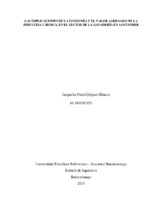| dc.contributor.advisor | Director. Arenas Fajardo, Reinaldo | |
| dc.contributor.author | Quijano Blanco, Jacquelin Paola | |
| dc.coverage.temporal | 2019 | |
| dc.date.accessioned | 2021-05-12T17:26:36Z | |
| dc.date.available | 2021-05-12T17:26:36Z | |
| dc.date.issued | 2019-11 | |
| dc.identifier.uri | http://hdl.handle.net/20.500.11912/8516 | |
| dc.description | 146p.: (pdf); il; imágenes; gráficas; tablas; anexos. | spa |
| dc.description.abstract | La ganadería se encuentra en crisis y este camino de crisis, es ocasionado por la baja competitividad del país. A
pesar de estas circunstancias, se reconoce el hecho de que Colombia tiene un gran potencial. Además es
importante considerar la tendencia positiva hacia el consumo de carne, sobre todo por los países desarrollados
con mayor ingreso per cápita. Aún así, los tratados de Colombia, son desaprovechados, se exporta más ganado
en pie que carne, pero se importan productos con valor agregado y los países a los cuáles se exporta son
mercados con precios bajos. Para este proyecto, se realiza un análisis descriptivo de fuentes secundarias y se
construyen instrumentos de investigacion en actores involucrados del sector. De manera que se describe la
situación actual de la ganadería en Santander, y se generan las implicaciones de la agregación de valor
agregado en la industria cárnica, como mejoramiento para las condiciones actuales de los ganaderos y de la
economía de la región. En San Vicente de Chucurí, donde se recogió información, se concluye que la gran
mayoría de ganaderos encuestados son pequeños ganaderos, con una cultura cerrada ante el cambio, manejan
una ganadería tradicional, no agregan valor a su producto, no implementan tecnología en sus fincas y solo un
18% ha recibido capacitaciones por parte del gobierno. El gobierno debe manifestarse, pues sus proyectos del
sector ganadero, no se ven reflejados en San Vicente de Chucurí. Así mismo, el sector ganadero en Colombia
necesita capacitar y propagar información, modernización, planes desarrollados que permiten renovar y darle un
impulso. Respecto al valor agregado, se aprecia al comparar tres empresas del sector cárnico, una de ellas que
implementa la transformación industrial, que la empresa con el EVA más estable y con el ROIC más elevado, es
aquella que implementa procesos de transformación industrial. | spa |
| dc.description.abstract | Livestock is in crisis and this crisis path is caused by the low competitiveness of the country. Despite these
circumstances, the fact that Colombia has a great potential is recognized. It is also important to consider the
positive trend towards meat consumption, especially for developed countries with higher per capita income. Even
so, the Colombian treaties are wasted, more live cattle are exported than meat, but value-added products are
imported and the countries to which they are exported are markets with low prices. For this project, a descriptive
analysis of secondary sources is carried out and research instruments are built on stakeholders in the sector. So
the current situation of livestock in Santander is described, and the implications of the added value aggregation in
the meat industry are generated, as an improvement to the current conditions of the farmers and the economy of
the region. In San Vicente de Chucurí, where information was collected, it is concluded that the vast majority of
farmers surveyed are small farmers, with a culture closed to change, manage a traditional livestock, do not add
value to their product, do not implement technology on their farms and only 18% have received training from the
government. The government must demonstrate, as its livestock sector projects are not reflected in San Vicente
de Chucurí. Likewise, the livestock sector in Colombia needs to train and spread information, modernization,
developed plans that allow to renew and give it a boost. Regarding the added value, it is appreciated when
comparing three companies of the meat sector, one of them that implements the industrial transformation, that
the company with the most stable EVA and with the highest ROIC, is the one that implements industrial
transformation processes. | eng |
| dc.format.mimetype | application/pdf | |
| dc.language.iso | spa | |
| dc.publisher | Universidad Pontificia Bolivariana | spa |
| dc.rights | Attribution-NonCommercial-NoDerivatives 4.0 International | * |
| dc.rights.uri | http://creativecommons.org/licenses/by-nc-nd/4.0/ | * |
| dc.subject | Ganadería | spa |
| dc.subject | Valor agregado | spa |
| dc.subject | Indicadores de productividad | spa |
| dc.subject | Carne | spa |
| dc.subject | San Vicente de Chucurí (Santander, Colombia) | spa |
| dc.subject | Planes de desarrollo | spa |
| dc.title | Las implicaciones de la economía y el valor agregado de la industria cárnica, en el sector de la ganadería en Santander | spa |
| dc.type | Trabajo de grado | spa |
| dc.publisher.department | Escuela de Ingenierías | spa |
| dc.publisher.program | Ingeniería Industrial | spa |
| dc.type.hasVersion | publishedVersion | spa |
| dc.description.sectional | Bucaramanga | spa |
| dc.description.degreename | Ingeniero Industrial | spa |


